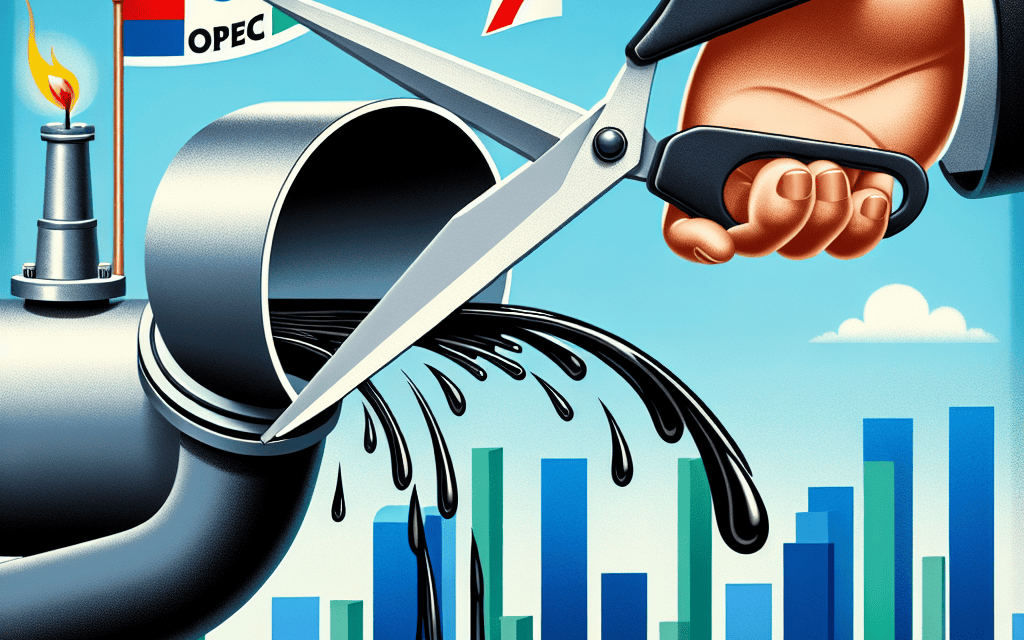“Short-Term Spike: OPEC’s Extended Cuts Fuel Oil Price Surge”
Introduction
In recent developments within the global energy market, the Organization of the Petroleum Exporting Countries (OPEC) has implemented extended production cuts, leading to a temporary surge in oil prices. This strategic move by OPEC, aimed at stabilizing the market and bolstering prices amidst fluctuating demand, has significant implications for both producers and consumers worldwide. The decision to prolong output reductions reflects OPEC’s ongoing efforts to manage supply dynamics in response to economic uncertainties and geopolitical tensions. As a result, the oil market has experienced a notable uptick in prices, impacting various sectors and prompting discussions on the long-term sustainability of such measures.
Impact Of OPEC’s Extended Cuts On Global Oil Markets
The recent decision by the Organization of the Petroleum Exporting Countries (OPEC) to extend its production cuts has led to a temporary surge in global oil prices, a development that has significant implications for the global oil markets. This strategic move by OPEC, aimed at stabilizing the market and supporting prices, comes in response to a variety of economic pressures and geopolitical factors that have influenced supply and demand dynamics. As the world grapples with these changes, the impact of OPEC’s decision is being felt across different sectors and regions.
To begin with, the extension of production cuts by OPEC has resulted in a noticeable increase in oil prices, as the reduction in supply has created a tighter market. This price surge, while beneficial for oil-producing nations seeking to bolster their revenues, poses challenges for oil-importing countries that are now facing higher energy costs. The ripple effects of these increased costs are likely to be felt in various industries, from transportation to manufacturing, as businesses adjust to the new pricing environment. Consequently, consumers may experience higher prices for goods and services, potentially impacting economic growth in some regions.
Moreover, the decision by OPEC to extend its cuts is not occurring in isolation. It is part of a broader strategy to manage the delicate balance between supply and demand in the global oil market. In recent years, the market has been characterized by volatility, driven by factors such as fluctuating demand due to economic cycles, technological advancements in alternative energy sources, and geopolitical tensions in key oil-producing regions. By extending production cuts, OPEC aims to mitigate some of this volatility and provide a more stable environment for both producers and consumers.
However, the temporary nature of the price surge suggests that the market may eventually adjust as other producers respond to the changes in supply dynamics. Non-OPEC countries, particularly those with significant shale oil production capabilities, may increase their output to capitalize on higher prices, potentially offsetting the impact of OPEC’s cuts. This could lead to a rebalancing of the market, with prices stabilizing at a new equilibrium. Additionally, the global push towards renewable energy and the increasing emphasis on sustainability may further influence long-term demand for oil, as countries seek to reduce their reliance on fossil fuels.
In the short term, the extended cuts by OPEC have provided a boost to oil prices, offering some relief to member countries that rely heavily on oil revenues. However, the broader implications for the global economy are complex and multifaceted. As countries navigate the challenges posed by higher energy costs, there may be increased pressure on policymakers to explore alternative energy sources and invest in energy efficiency measures. This could accelerate the transition towards a more diversified energy landscape, with potential benefits for both economic stability and environmental sustainability.
In conclusion, while OPEC’s decision to extend production cuts has led to a temporary surge in oil prices, the long-term impact on global oil markets remains uncertain. The interplay between supply and demand, coupled with the ongoing transition towards renewable energy, will continue to shape the future of the oil industry. As stakeholders across the globe adapt to these changes, the need for strategic planning and collaboration becomes increasingly important to ensure a balanced and sustainable energy future.
Short-Term Economic Effects Of Rising Oil Prices
The recent decision by the Organization of the Petroleum Exporting Countries (OPEC) to extend production cuts has led to a temporary surge in oil prices, a development that has significant short-term economic implications. As oil prices rise, the immediate effects are felt across various sectors, influencing both consumer behavior and broader economic indicators. Understanding these short-term economic effects is crucial for policymakers, businesses, and consumers alike.
Initially, the most direct impact of rising oil prices is observed in the transportation sector. As fuel costs increase, transportation expenses for both individuals and businesses rise correspondingly. For consumers, this often translates into higher prices at the pump, which can lead to reduced discretionary spending. When individuals allocate more of their budget to fuel, they tend to cut back on non-essential purchases, thereby affecting retail sales and potentially slowing economic growth. For businesses, particularly those heavily reliant on logistics and transportation, increased fuel costs can lead to higher operational expenses. Companies may respond by passing these costs onto consumers through higher prices for goods and services, contributing to inflationary pressures.
Moreover, the manufacturing sector also feels the pinch of rising oil prices. Many manufacturing processes are energy-intensive, and higher oil prices can lead to increased production costs. This scenario can result in a ripple effect throughout the supply chain, as manufacturers may raise prices to maintain profit margins. Consequently, this can lead to higher prices for finished goods, further exacerbating inflation. In the short term, businesses may face difficult decisions regarding pricing strategies and cost management to remain competitive in an environment of rising input costs.
In addition to affecting consumer behavior and business operations, rising oil prices can have broader macroeconomic implications. One such effect is the potential for increased inflation. As mentioned earlier, higher transportation and production costs can lead to higher prices for goods and services. Central banks may respond to rising inflation by adjusting monetary policy, such as increasing interest rates to curb spending and stabilize prices. However, such measures can also slow economic growth, creating a delicate balancing act for policymakers.
Furthermore, the impact of rising oil prices is not uniform across all economies. Oil-importing countries are likely to experience more pronounced negative effects, as they face higher import bills and potential trade imbalances. Conversely, oil-exporting nations may benefit from increased revenues, which can bolster their economies in the short term. This divergence can lead to shifts in global economic dynamics, influencing trade relationships and geopolitical considerations.
Despite these challenges, it is important to note that the surge in oil prices due to OPEC’s extended cuts is expected to be temporary. Market forces, such as increased production from non-OPEC countries or a slowdown in global demand, could eventually stabilize prices. Additionally, advancements in alternative energy sources and increased energy efficiency may mitigate the long-term impact of oil price fluctuations.
In conclusion, the short-term economic effects of rising oil prices, driven by OPEC’s extended production cuts, are multifaceted and complex. They influence consumer behavior, business operations, and macroeconomic indicators, creating challenges for policymakers and stakeholders. While the immediate impact may be disruptive, understanding these dynamics is essential for navigating the economic landscape and preparing for future fluctuations in the oil market.
How OPEC’s Strategy Influences Energy Policy Worldwide
The recent decision by the Organization of the Petroleum Exporting Countries (OPEC) to extend production cuts has led to a temporary surge in oil prices, a development that has significant implications for global energy policy. This strategic move by OPEC, aimed at stabilizing the oil market, underscores the organization’s influential role in shaping energy dynamics worldwide. As oil prices rise, countries across the globe are compelled to reassess their energy policies, balancing economic growth with energy security and environmental considerations.
OPEC’s strategy of managing oil supply to influence prices is not a novel approach; however, its impact is profound and far-reaching. By curtailing production, OPEC effectively reduces the global oil supply, which in turn exerts upward pressure on prices. This price increase can have a cascading effect on various sectors, from transportation to manufacturing, as oil remains a critical input for numerous industries. Consequently, countries that are heavily reliant on oil imports may experience increased costs, prompting them to explore alternative energy sources or to enhance energy efficiency measures.
In response to OPEC’s production cuts and the resultant price fluctuations, many nations are revisiting their energy policies. For instance, countries with significant oil reserves may consider ramping up domestic production to capitalize on higher prices, thereby boosting their economies. Conversely, nations with limited oil resources might accelerate their transition to renewable energy sources, such as wind, solar, and hydroelectric power, to reduce their dependency on imported oil. This shift not only mitigates the impact of volatile oil prices but also aligns with global efforts to combat climate change by reducing carbon emissions.
Moreover, the temporary surge in oil prices can influence geopolitical dynamics, as energy security becomes a paramount concern for many governments. Countries may seek to strengthen alliances with oil-producing nations to ensure a stable supply of energy, while also diversifying their energy portfolios to include a mix of fossil fuels and renewables. This strategic diversification can enhance resilience against future market disruptions and contribute to a more sustainable energy landscape.
OPEC’s influence extends beyond immediate price adjustments, as its actions can also shape long-term energy strategies. Policymakers must consider the potential for future production cuts or increases when formulating energy policies, taking into account the organization’s historical patterns and strategic objectives. This necessitates a comprehensive understanding of global oil markets and the ability to anticipate shifts in supply and demand dynamics.
In addition to influencing national energy policies, OPEC’s actions can also impact international energy cooperation. As countries navigate the complexities of the global energy market, there is an increasing need for collaboration on issues such as energy efficiency, technology transfer, and the development of clean energy solutions. By working together, nations can address shared challenges and capitalize on opportunities to create a more sustainable and secure energy future.
In conclusion, OPEC’s decision to extend production cuts and the subsequent rise in oil prices serve as a reminder of the organization’s pivotal role in the global energy landscape. As countries grapple with the implications of these developments, they are prompted to reevaluate their energy policies, considering both immediate economic impacts and long-term sustainability goals. Through strategic planning and international cooperation, nations can navigate the complexities of the energy market and work towards a more resilient and environmentally conscious future.
The Role Of Non-OPEC Producers In Stabilizing Oil Prices

The recent decision by the Organization of the Petroleum Exporting Countries (OPEC) to extend production cuts has led to a temporary surge in oil prices, highlighting the intricate dynamics of the global oil market. While OPEC’s influence on oil prices is undeniable, the role of non-OPEC producers in stabilizing these prices is equally significant. As the global economy continues to recover from the disruptions caused by the COVID-19 pandemic, understanding the interplay between OPEC and non-OPEC producers becomes crucial.
Non-OPEC producers, including major players like the United States, Russia, and Canada, have a substantial impact on the global oil supply. These countries, often referred to as “swing producers,” have the capacity to adjust their production levels in response to market conditions. This flexibility allows them to counterbalance OPEC’s production decisions, thereby contributing to the stabilization of oil prices. For instance, when OPEC implements production cuts to boost prices, non-OPEC producers may increase their output to capitalize on higher prices, thus preventing excessive price spikes.
Moreover, technological advancements in oil extraction, particularly in shale oil production, have empowered non-OPEC producers to respond swiftly to market changes. The United States, in particular, has emerged as a dominant force in the global oil market due to its shale revolution. This has not only increased its production capacity but also enhanced its ability to influence global oil prices. Consequently, the interplay between OPEC’s strategic decisions and the responsive actions of non-OPEC producers creates a dynamic equilibrium that helps stabilize prices over time.
In addition to production adjustments, non-OPEC producers play a vital role in stabilizing oil prices through strategic collaborations and alliances. The OPEC+ agreement, which includes both OPEC and non-OPEC countries like Russia, exemplifies such cooperation. By coordinating production levels, these countries aim to manage supply and demand effectively, thereby reducing price volatility. This collaboration underscores the recognition that a stable oil market benefits all producers, as it fosters economic growth and ensures energy security.
Furthermore, non-OPEC producers contribute to price stabilization by investing in alternative energy sources and diversifying their energy portfolios. As the world increasingly shifts towards renewable energy, these producers are exploring sustainable options to reduce their reliance on oil revenues. This transition not only mitigates the impact of oil price fluctuations on their economies but also aligns with global efforts to combat climate change. By investing in renewable energy, non-OPEC producers are positioning themselves as key players in the future energy landscape, thereby influencing long-term oil price stability.
In conclusion, while OPEC’s production cuts have led to a temporary surge in oil prices, the role of non-OPEC producers in stabilizing these prices cannot be overlooked. Through their ability to adjust production levels, engage in strategic collaborations, and invest in alternative energy sources, non-OPEC producers play a crucial role in maintaining a balanced oil market. As the global energy landscape continues to evolve, the interplay between OPEC and non-OPEC producers will remain a defining factor in shaping oil prices. Understanding this dynamic is essential for policymakers, industry stakeholders, and consumers alike, as it influences economic stability and energy security on a global scale.
Consumer Reactions To Temporary Oil Price Surges
The recent decision by the Organization of the Petroleum Exporting Countries (OPEC) to extend production cuts has led to a temporary surge in oil prices, a development that has not gone unnoticed by consumers worldwide. As oil prices rise, the ripple effects are felt across various sectors, influencing consumer behavior and prompting a range of reactions. Understanding these reactions requires a closer examination of the interconnectedness of global markets and consumer sentiment.
Initially, the immediate impact of rising oil prices is most evident at the gas pump. Consumers, particularly those in regions heavily reliant on personal vehicles, experience an increase in fuel costs. This change often leads to a shift in consumer behavior, as individuals seek ways to mitigate the impact on their personal finances. For instance, some consumers may opt to reduce non-essential travel, carpool with others, or utilize public transportation more frequently. These adjustments, while seemingly minor, reflect a broader trend of consumers adapting to fluctuating economic conditions.
Moreover, the surge in oil prices extends beyond the direct cost of fuel. It influences the price of goods and services, as transportation costs are a significant component of the supply chain. Consequently, consumers may notice an increase in the price of everyday items, from groceries to clothing. This phenomenon can lead to a tightening of household budgets, as individuals prioritize essential purchases over discretionary spending. In turn, this shift in spending patterns can have a cascading effect on the economy, impacting businesses that rely on consumer spending for growth.
In response to these changes, some consumers may turn to alternative energy sources or more fuel-efficient technologies. The temporary surge in oil prices can act as a catalyst for increased interest in electric vehicles, hybrid cars, and renewable energy solutions. As consumers become more conscious of their energy consumption, there is a growing demand for products and services that offer long-term savings and environmental benefits. This shift not only reflects a change in consumer preferences but also signals a potential transformation in the energy market.
Furthermore, consumer reactions to temporary oil price surges are often influenced by broader economic conditions and individual financial circumstances. In times of economic uncertainty, such as during a recession or periods of high inflation, consumers may be more sensitive to price changes and more likely to alter their spending habits. Conversely, in a robust economic environment, consumers may be more resilient to temporary price fluctuations, viewing them as a short-term inconvenience rather than a significant financial burden.
It is also important to consider the role of consumer sentiment in shaping reactions to oil price changes. Media coverage and public discourse can amplify perceptions of economic instability, leading to heightened consumer anxiety and more pronounced behavioral shifts. In this context, clear communication from policymakers and industry leaders can help manage expectations and provide reassurance to consumers navigating these changes.
In conclusion, OPEC’s decision to extend production cuts and the resulting temporary surge in oil prices have elicited a range of consumer reactions. From altering travel habits to exploring alternative energy sources, consumers are actively responding to the economic implications of rising oil prices. These reactions underscore the complex interplay between global markets and individual behavior, highlighting the need for adaptive strategies in an ever-changing economic landscape. As consumers continue to navigate these challenges, their responses will undoubtedly shape the future of energy consumption and economic resilience.
Long-Term Implications Of OPEC’s Production Decisions
The recent decision by the Organization of the Petroleum Exporting Countries (OPEC) to extend production cuts has led to a temporary surge in oil prices, a development that has captured the attention of global markets. This move, while providing short-term relief to oil-producing nations by boosting revenues, raises questions about the long-term implications for both the global economy and the energy sector. As OPEC continues to wield its influence over oil production, the ripple effects of its decisions are felt far beyond the immediate fluctuations in oil prices.
To begin with, the immediate impact of OPEC’s production cuts is evident in the rise of oil prices. By reducing the supply of oil, OPEC aims to stabilize the market and prevent prices from plummeting. This strategy has proven effective in the short term, as evidenced by the recent uptick in prices. However, this approach is not without its challenges. Higher oil prices can lead to increased costs for consumers and businesses, potentially slowing economic growth. Moreover, countries that are heavily reliant on oil imports may find themselves facing inflationary pressures, which could complicate monetary policy decisions.
In addition to the economic implications, OPEC’s production cuts have significant geopolitical ramifications. Countries that are part of OPEC, as well as those that are not, must navigate a complex landscape of alliances and rivalries. For instance, non-OPEC oil-producing nations may choose to increase their production to capitalize on higher prices, potentially undermining OPEC’s efforts to control the market. Furthermore, the interplay between OPEC’s decisions and the policies of major oil-consuming countries, such as the United States and China, adds another layer of complexity to the global energy equation.
Transitioning to the environmental perspective, OPEC’s production decisions also have implications for the transition to renewable energy. As the world grapples with the urgent need to address climate change, the reliance on fossil fuels remains a contentious issue. Higher oil prices could incentivize investment in alternative energy sources, as consumers and businesses seek to reduce their dependence on oil. However, if OPEC’s production cuts lead to sustained high prices, there is a risk that the transition to renewables could be slowed, as oil-producing countries may prioritize short-term economic gains over long-term sustainability goals.
Moreover, the technological advancements in the energy sector cannot be overlooked. The rise of shale oil production, particularly in the United States, has introduced a new dynamic to the global oil market. Shale producers, with their ability to quickly ramp up production, can respond to price signals more rapidly than traditional oil producers. This flexibility poses a challenge to OPEC’s ability to maintain control over the market, as it must contend with the potential for increased competition from non-OPEC producers.
In conclusion, while OPEC’s decision to extend production cuts has led to a temporary surge in oil prices, the long-term implications of such actions are multifaceted and complex. The interplay between economic, geopolitical, environmental, and technological factors will continue to shape the global energy landscape. As stakeholders across the spectrum navigate these challenges, the need for a balanced approach that considers both immediate and future impacts becomes increasingly apparent. Ultimately, the decisions made by OPEC and other key players will have lasting consequences for the global economy and the ongoing transition to a more sustainable energy future.
Analyzing The Geopolitical Consequences Of Oil Price Fluctuations
The recent decision by the Organization of the Petroleum Exporting Countries (OPEC) to extend production cuts has led to a temporary surge in oil prices, a development that carries significant geopolitical implications. As oil remains a critical component of the global economy, fluctuations in its price can have far-reaching effects on both producing and consuming nations. The immediate impact of OPEC’s decision is evident in the financial markets, where the price of crude oil has experienced a notable increase. This surge, while beneficial to oil-exporting countries in the short term, introduces a complex array of challenges and opportunities on the geopolitical stage.
To begin with, the rise in oil prices provides a financial boon to OPEC member states and other oil-exporting countries. These nations, many of which rely heavily on oil revenues to support their economies, can use the increased income to bolster their fiscal positions. For countries like Saudi Arabia and Russia, higher oil prices can help fund domestic projects and stabilize their economies, which have been under pressure due to fluctuating oil markets and global economic uncertainties. However, this financial relief is not without its complications. The increased revenue may reduce the urgency for these countries to diversify their economies, a long-term strategic necessity given the global shift towards renewable energy sources.
Conversely, oil-importing countries face a different set of challenges. Higher oil prices translate into increased costs for industries reliant on petroleum products, such as transportation and manufacturing. This can lead to inflationary pressures, which central banks may need to address through monetary policy adjustments. For developing nations, the impact can be particularly severe, as rising energy costs can strain already limited financial resources and hinder economic growth. Consequently, these countries may seek to strengthen diplomatic ties with oil-producing nations to secure more favorable trade terms or explore alternative energy sources to mitigate their dependence on oil imports.
Moreover, the geopolitical landscape is further complicated by the interplay between OPEC’s actions and the policies of major non-OPEC oil producers, such as the United States. The U.S., with its significant shale oil production, has the potential to influence global oil supply dynamics. In response to OPEC’s production cuts, American producers may increase output to capitalize on higher prices, potentially offsetting OPEC’s efforts to control supply and stabilize prices. This dynamic creates a delicate balance of power, where strategic decisions by one group can have ripple effects across the global energy market.
In addition to economic considerations, the geopolitical consequences of oil price fluctuations extend to international relations and security. Countries with significant energy dependencies may find themselves more vulnerable to political pressures from oil-exporting nations. This can lead to shifts in alliances and influence global diplomatic strategies. For instance, nations seeking to reduce their reliance on Middle Eastern oil might strengthen ties with alternative suppliers or invest in domestic energy production capabilities.
In conclusion, while OPEC’s extended production cuts have led to a temporary surge in oil prices, the broader geopolitical consequences are complex and multifaceted. The interplay between economic benefits for oil-exporting countries and challenges for importing nations underscores the intricate nature of global energy politics. As the world continues to navigate these fluctuations, the importance of strategic planning and international cooperation becomes increasingly evident, highlighting the need for a balanced approach to energy security and economic stability.
Q&A
1. **What is OPEC?**
OPEC, the Organization of the Petroleum Exporting Countries, is an intergovernmental organization of oil-producing nations that coordinates and unifies petroleum policies among member countries to stabilize oil markets.
2. **What are OPEC’s extended cuts?**
OPEC’s extended cuts refer to the decision by OPEC and its allies (OPEC+) to continue reducing oil production levels beyond the initially agreed period to manage supply and support oil prices.
3. **Why did OPEC extend production cuts?**
OPEC extended production cuts to address oversupply concerns, stabilize the market, and support higher oil prices amid fluctuating global demand.
4. **How do production cuts affect oil prices?**
Production cuts reduce the supply of oil in the market, which can lead to higher prices if demand remains constant or increases, as reduced supply typically drives prices up.
5. **What was the immediate impact of OPEC’s extended cuts on oil prices?**
The immediate impact of OPEC’s extended cuts was a temporary surge in oil prices as markets reacted to the anticipated tighter supply.
6. **Are the effects of OPEC’s cuts on oil prices permanent?**
The effects are not necessarily permanent; while cuts can lead to short-term price increases, long-term prices depend on various factors, including global demand, economic conditions, and geopolitical events.
7. **What are potential risks of extended production cuts?**
Potential risks include encouraging increased production from non-OPEC countries, potential demand destruction due to high prices, and economic strain on countries reliant on oil revenue.
Conclusion
OPEC’s decision to extend production cuts has led to a temporary surge in oil prices, reflecting the organization’s influence over global oil markets. By reducing supply, OPEC aims to stabilize or increase prices, benefiting member countries economically. However, this strategy can also lead to short-term volatility as markets adjust to the new supply dynamics. While higher prices may boost revenues for oil-exporting nations, they can also strain economies dependent on oil imports and accelerate the transition to alternative energy sources. The long-term impact of these cuts will depend on global economic conditions, geopolitical factors, and the pace of energy transition efforts.





